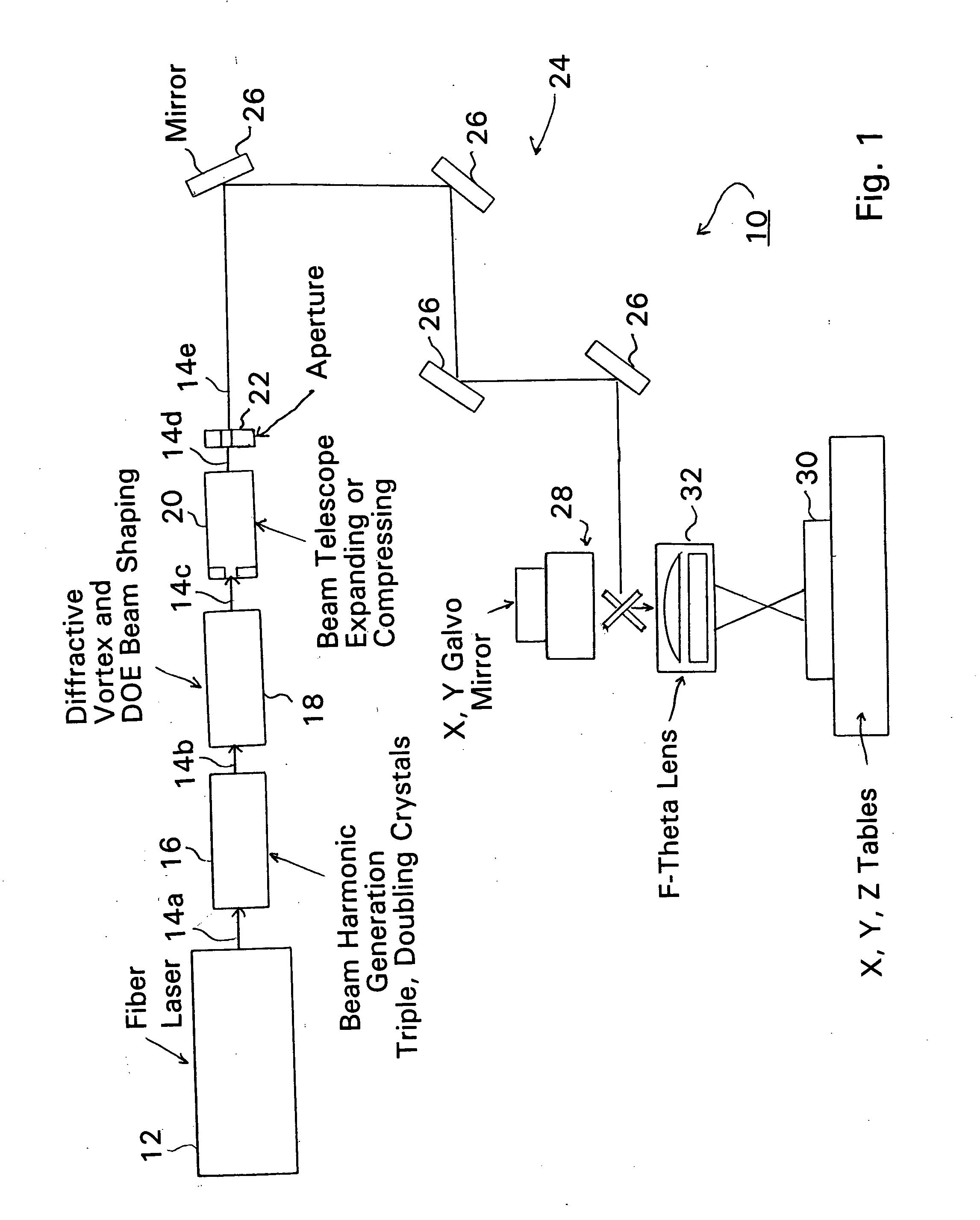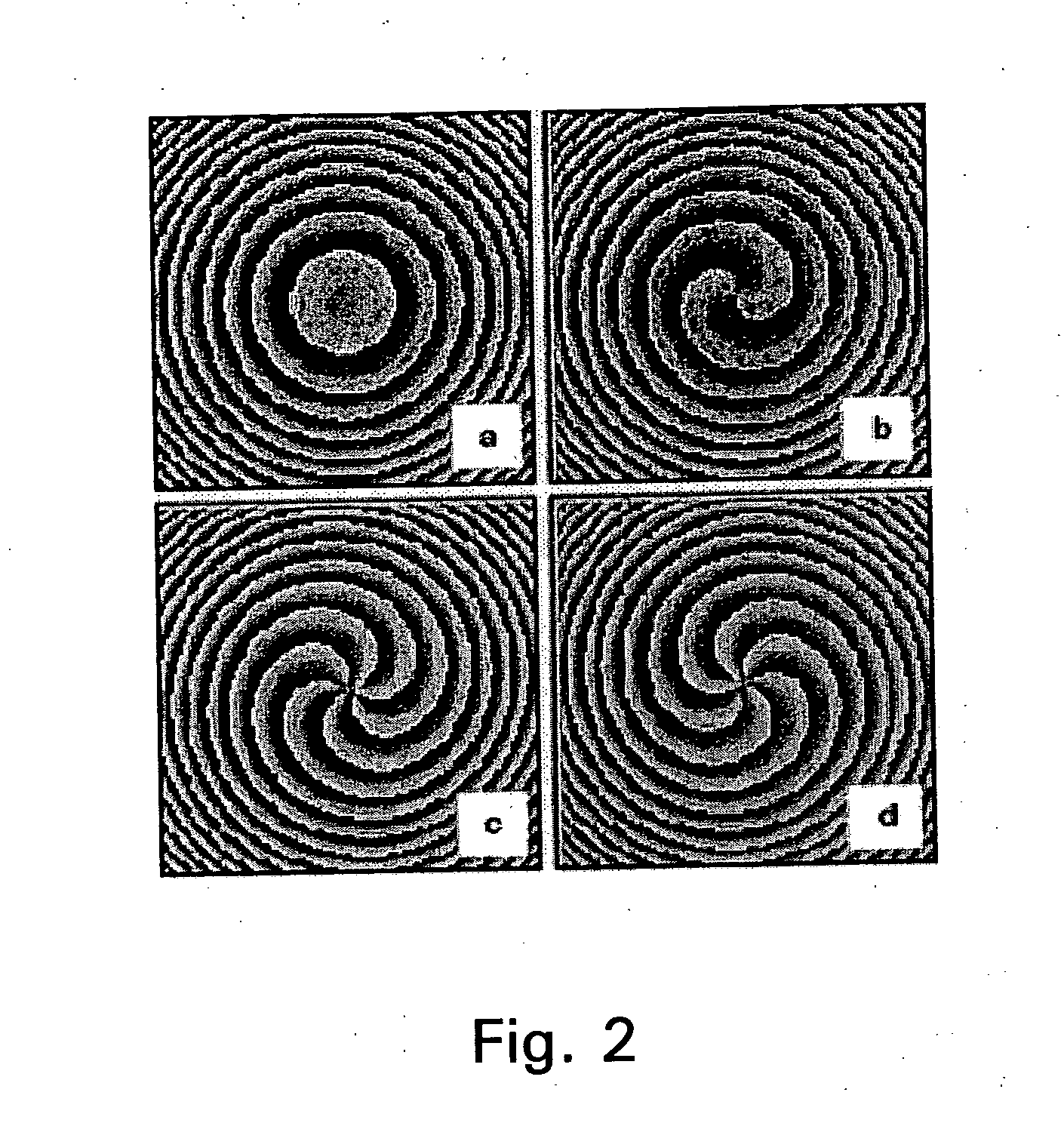Fiber lasers also suffer from other problems, which are often shared with or stem from the lasers used to pump the fiber lasers.
Considering the problems arising from the lasers used to pump the fiber lasers, the
Diode Pumped
Solid State (DPSS) lasers currently and commonly used to drive fiber lasers produce a single mode beam and typically suffer from pointing and drift instabilities as well as from limits on the power that can be delivered by the DPSS
laser, which is typically in the range of 10 Watts @ 355 nm (nanometers) and 2 to 3 watts @266 nm.
That is, and for example, DPSS lasers may produce useful
Gaussian and TEM00 mode beam outputs as well as a single mode beam outputs, but these
modes, and in particular the single mode beam output, do not provide the highest output power.
Beam shaping technology and uniform flat top beams, however, require a stable laser input beam and, discussed below, it is difficult to obtain a stable output beam from a DPSS laser.
For example, the DPSS lasers commonly used for drilling multi-layered printed circuit boards for producing
chip packaging / carriers generate a single mode output beam that becomes unstable when certain critical parameters, such as pump current and pulse repetition rate, are changed, or because of certain conditions arising from operation of the laser, such as
thermal lensing or heating due to power dissipation.
Such variations in the laser parameters may result, for example, in long term beam movement or drift and beam drift and pointing
instability drift.
Long term beam movement or drift may result in
system down time since the
optical beam delivery system must be realigned when the beam displacement exceeds tolerable limits, while short term beam movement or drift will typically result in
distortion of the beam profile, the formation of hot and cold spots in the beam, and a loss in efficiency and in the power levels delivered by the laser beam.
Certain other problems are common and critical to
fiber laser systems as well as to the laser
machining systems of the prior art and one of the most significant of these problems is control of the laser
beam pulse width, repetition rate, frequency and power characteristics to achieve the optimum effect at the workpiece being machined.
The performance of DPSS UV lasers is limited in its
processing capabilities, however, due to its beam
propagation factor, which is typically in the range M2=<1.2, as well as by the fact that the drilling process is limited solely to UV
ablation.
UV DPSS lasers are also limited in their ability to dice or
cut multilayered
printed circuit board materials and other
semiconductor wafer materials due to the etch rate of materials in of UV wavelengths, which is a function of the absorption of UV light in the materials, and because of variations or differences in the
ablation energy density required for different materials as the DPSS laser cuts through the single and multiple
layers of different materials.
It must also be noted that while the etch rate of a given laser can be increased by increasing the laser output power, repetition rate or pulse width, or any combination thereof, such efforts can as easily be counterproductive for a number of reasons.
In addition, simply increasing the power delivered to the target material may cause undesired effects at the target material, such as loss of control of the drilling or
cutting dimensions, ragged cuts, blocking of the laser beam by the ablated material, thereby actually reducing the power delivered to the material, and unwanted deposits of ablated material in the drilling or
cutting area, thus damaging the surface of the target material.
As discussed above, UV DPSS lasers also have problems with beam pointing and drift stability because the laser rods are
diode pumped, which causes the rods to heat and thereby results in problems with thermal drift and pointing stability.
The
thermal lensing and
harmonic generation processes required to convert the fundamental IR
radiation of the lasers to the UV range required for the desired laser output beam also creates further issues with stability.
In addition, the
optical efficiency of UV DPSS lasers is relatively low due to inefficient
diode pumping methods and the resulting energy losses are translated into heat, which further aggravates the problems with thermal drift and pointing stability.
As also discussed above, UV DPSS lasers are limited to operating in either a
pulsed mode output or a
continuous mode output but a UV DPSS laser cannot generate both mode outputs simultaneously, thereby limiting the ability of a
system using UV DPSS lasers to generate the output beamforms most suited for different applications and materials.
UV DPSS lasers also suffer from beam propagation issues due to its beam propagation value which is approximately M2=<1.2, which creates problems when using
beam shaping technology such as diffractive optical elements and holographic optical elements by causing
ringing effects.
The
ringing effects cannot be compensated for and generate undesirable laser beam imaging properties at the target material being processed.
 Login to View More
Login to View More 


